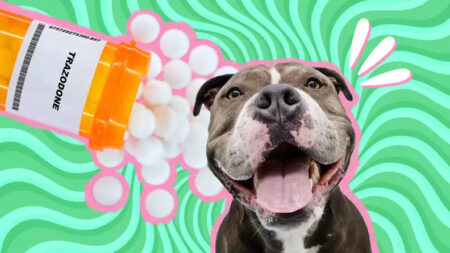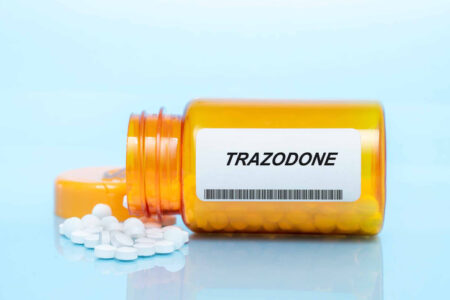Trazodone is a medication that is commonly used to treat various psychiatric and behavioral conditions in both humans and dogs. It belongs to a class of drugs known as serotonin antagonists and reuptake inhibitors (SARIs) and works by increasing the levels of the neurotransmitter serotonin in the brain. While it is primarily prescribed for humans to treat conditions such as depression, anxiety, and insomnia, it has also been found to be effective for certain behavioral issues in dogs. With the increasing use of Trazodone in veterinary medicine, many pet owners may wonder if the medication is the same for dogs as it is for humans.
In this article, we will explore the similarities and differences between Trazodone for humans and dogs, and discuss its uses, dosage, and potential side effects in both species.
Is Trazodone For Dogs The Same As For Humans?
Yes, trazodone is used to treat similar conditions in both dogs and humans, such as anxiety, depression, and insomnia. However, the dosage and administration of the drug may differ between the two species. It is important to follow the recommendations of a veterinarian when giving trazodone to a dog. Do not give your dog trazodone that has been prescribed for a human, and do not give human trazodone to your dog without consulting a veterinarian first.
What Is Trazodone Used To Treat?
Trazodone is primarily used to treat major depressive disorder (MDD), but it may also be prescribed for other conditions, such as insomnia and anxiety disorders. It is an antidepressant medication that belongs to the family of drugs known as serotonin antagonists and reuptake inhibitors (SARIs). Trazodone works by increasing levels of serotonin in the brain, a chemical messenger that helps regulate mood, sleep, and other bodily functions. In addition to MDD, trazodone may be prescribed off-label to treat conditions such as:
- Insomnia: Trazodone is commonly used off-label to treat insomnia, particularly for individuals who also experience depression or anxiety. Unlike many other antidepressants, trazodone has sedative effects that can help improve sleep.
- Anxiety disorders: Trazodone may also be used off-label to treat anxiety disorders, such as generalized anxiety disorder (GAD), panic disorder, and post-traumatic stress disorder (PTSD). Its calming effects can help reduce symptoms of anxiety and improve overall well-being.
- Fibromyalgia: Trazodone may be used off-label to treat fibromyalgia, a chronic pain disorder that also affects mood, energy levels, and sleep. Trazodone’s sedative effects may help improve sleep quality for individuals with fibromyalgia, and its antidepressant effects may also help improve mood and reduce pain.
- Obsessive-compulsive disorder (OCD): In some cases, trazodone may be used off-label to treat symptoms of OCD, a mental health disorder characterized by uncontrollable, repetitive thoughts and behaviors. Trazodone’s effects on serotonin levels may help reduce obsessive thoughts and compulsive behaviors.
- Chronic pain: Trazodone may be prescribed off-label to help manage chronic pain, such as fibromyalgia, arthritis, and neuropathic pain. Its sedative effects may help improve sleep, which in turn can help reduce pain levels and improve overall well-being. Trazodone may also be used in conjunction with other pain-relieving medications.
Trazodone Dosage For Dogs
The dosage of trazodone for dogs will vary depending on the size and weight of the dog, as well as the condition being treated. Typically, a dog will be given a dosage of between 1 and 3 mg per pound of body weight. For example, a 30-pound dog would typically be given a dosage of between 30 and 90 mg. However, it is important to follow the dosage instructions given by your veterinarian, as they will be able to determine the most appropriate dosage for your dog based on their specific needs.
How Is Trazodone For Dogs Administered?
Trazodone for dogs is typically administered orally in pill form. The pill can be given as a whole tablet or it can be crushed and mixed in with food. For dogs that are difficult to pill, it is possible to get trazodone in a liquid form that can be mixed in with food or water. If a dog is experiencing extreme anxiety or aggression, trazodone may be administered as a transdermal gel that is applied to the skin. Trazodone should not be crushed or broken up in any way without consulting a veterinarian first, as this can affect how the drug is absorbed by the body.
How Does Trazodone Work When Prescribed For A Dog?
Trazodone works by increasing the levels of serotonin in the brain. Serotonin is a neurotransmitter that is responsible for regulating mood and behavior. When serotonin levels are low, it can lead to feelings of anxiety and depression. By increasing serotonin levels, trazodone can help to reduce feelings of anxiety and stress. In addition, trazodone can also help to reduce aggression and other behavioral problems.
Side Effects Of Trazodone
Trazodone is a medication commonly prescribed for dogs suffering from anxiety, depression, and other behavioral issues. While it can be effective in managing these conditions, there are potential side effects that dog owners should be aware of:
- Drowsiness and Sedation: Trazodone can cause drowsiness and sedation in dogs, which can be beneficial for those with anxiety or who have trouble sleeping. However, it can also make a dog lethargic and less alert, which can be dangerous, especially if the dog is taking part in activities such as agility training or sports.
- Dry Mouth: Trazodone can cause a decrease in saliva production, resulting in a dry mouth. This can lead to difficulty swallowing and an increased risk of choking, especially in older dogs. It can also make the dog more susceptible to dental problems and infections.
- Gastrointestinal Issues: Some dogs may experience gastrointestinal side effects such as nausea, vomiting, diarrhea, or constipation while taking Trazodone. This can be distressing for the dog and can lead to dehydration or other health problems if left untreated.
- Changes in Appetite: Trazodone can affect a dog’s appetite, causing them to eat more or less than usual. This can lead to weight gain or loss, which can harm the dog’s overall health.
- Behavioral Changes: In rare cases, Trazodone can cause a paradoxical reaction in dogs, leading to an increase in anxiety, aggression, or other behavioral changes. This can be concerning for dog owners and may require a change in medication.
- Allergic Reactions: Allergic reactions to Trazodone are rare but can occur in some dogs. Symptoms may include facial swelling, difficulty breathing, and hives. In severe cases, anaphylaxis may occur, which requires immediate medical attention.
SEE ALSO: Why Has My Dog Stopped Eating But Still Drinking Water?
Max Trazodone Dose For Dogs
The maximum trazodone dose for dogs is typically between 5 and 10 mg per pound of body weight. However, it is important to start with a lower dose and increase gradually as needed. Trazodone should never be given in doses higher than 10 mg per pound, as this can lead to side effects such as vomiting, lethargy, and seizures. Additionally, it is important to talk to your veterinarian before starting or increasing any dosage of trazodone, as they will be able to determine the appropriate dosage based on your dog’s individual needs.
What Happens If I Give My Dog Too Much Trazodone?
Giving your dog too much trazodone can lead to serious side effects, such as vomiting, lethargy, and seizures. If your dog has ingested too much trazodone, it is important to contact your veterinarian or an emergency animal hospital immediately. Depending on how much trazodone your dog has ingested, they may need to have their stomach pumped or may need to be given intravenous fluids.
Why Is My Dog Shaking After Taking Trazodone?
Shaking or tremors are a common side effect of trazodone, especially when the dog first starts taking the medication. In most cases, the shaking will subside after a few days as the dog’s body adjusts to the medication.
Cost Of Trazodone For Dogs
The cost of trazodone for dogs can vary depending on the dose and the size of the bottle. Generally, trazodone is relatively inexpensive, with a 30-day supply of the medication costing between $10 and $30. However, it is important to note that the cost of trazodone can vary depending on the pharmacy or pet supply store you purchase it from.
Trazodone For Humans
While trazodone is most commonly used as a medication for dogs, it is also sometimes prescribed to humans. In humans, trazodone is used to treat depression, anxiety, and insomnia. The dosage for humans is typically higher than the dosage for dogs, and the medication is usually taken once or twice a day. Trazodone can cause some side effects in humans, including drowsiness, dizziness, dry mouth, and constipation. If you are taking trazodone, it is important to follow your doctor’s instructions carefully and to talk to your doctor if you have any concerns about the medication.
What Is Trazodone Used For In Humans?
Trazodone is a medication primarily used in humans to treat symptoms of depression and anxiety disorders. It belongs to a class of drugs known as serotonin modulators, which work by increasing the levels of serotonin in the brain. Serotonin is a neurotransmitter that helps regulate mood, sleep, and other bodily functions. By increasing serotonin levels, trazodone can improve symptoms of depression and anxiety.
Trazodone can also be used off-label to treat other conditions, such as insomnia, chronic pain, and fibromyalgia. It may also be prescribed in combination with other medications for the treatment of bipolar disorder or schizophrenia. However, its effectiveness for these uses is not as well established as its use for depression and anxiety disorders.
Trazodone Dosage For Dogs VS Humans
The dosage of trazodone for dogs is typically much lower than the dosage for humans. The average trazodone dosage for dogs is between 1 and 10 mg per kilogram of body weight, while the average trazodone dosage for humans is between 150 and 400 mg per day. Trazodone is dosed differently for humans and dogs because dogs are more sensitive to the effects of the medication. As a result, a lower dose is needed to achieve the same therapeutic effect.
SEE ALSO: The Side Effects of Dog IV Fluid
FAQs
Q. Is there a difference between human trazodone and dog trazodone?
A. Trazodone is the same medication whether it is prescribed for humans or dogs. However, the dosages are different, and there may be some differences in the specific formulation of the medication.
Q. Can humans take dog Trazadone?
A. While humans and dogs both take trazodone for similar reasons (such as anxiety and depression), it is not recommended that humans take trazodone that is prescribed for dogs. This is because human trazodone is formulated to be dosed differently than dog trazodone.
Q. Can I use my trazodone for my dog?
A. It is not recommended to give your dog the trazodone that is prescribed for you. While the active ingredient may be the same, the dosage and formulation of the medication are likely different.
Q. What happens if a human takes trazodone?
A. If a human takes trazodone, it is possible that they may experience some side effects. The most common side effects of trazodone include drowsiness, dizziness, and dry mouth. In some cases, more serious side effects may occur, such as heart palpitations, confusion, and trouble breathing.
Conclusion
In conclusion, while trazodone is commonly used for both dogs and humans, there are some key differences between its usage and effects in each species. The dosage and potential side effects can vary greatly, and the drug needs to be prescribed and monitored by a veterinarian for dogs. Therefore, while the active ingredient may be the same, trazodone for dogs is not necessarily the same as the one used for humans. Pet owners need to consult with their veterinarian before administering any medication to their dogs.


